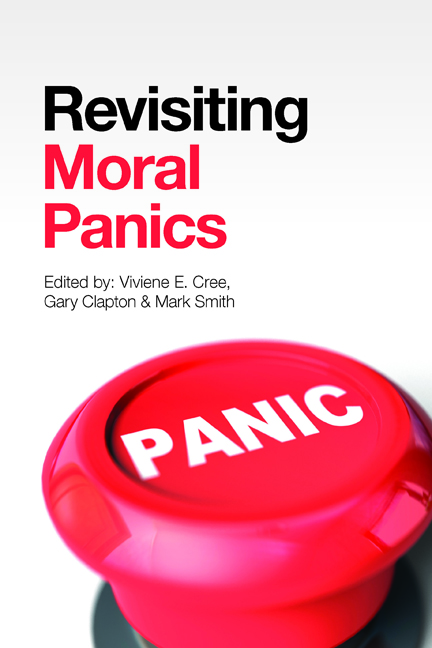Book contents
- Frontmatter
- Contents
- Contributors
- Preface
- Commentary moral panics yesterday, today and tomorrow
- Part One Gender and the family
- Part Two Moral panics in our time? Childhood and youth
- Part Three The state, government and citizens
- Part Four Moral crusades, moral regulation and morality
- Afterword the moral in moral panics
- Conclusion Moral panics and beyond
- Index
six - Child protection and moral panic
Published online by Cambridge University Press: 08 March 2022
- Frontmatter
- Contents
- Contributors
- Preface
- Commentary moral panics yesterday, today and tomorrow
- Part One Gender and the family
- Part Two Moral panics in our time? Childhood and youth
- Part Three The state, government and citizens
- Part Four Moral crusades, moral regulation and morality
- Afterword the moral in moral panics
- Conclusion Moral panics and beyond
- Index
Summary
Introduction
A condition, episode, person or group of persons emerges to become defined as a threat to societal values and interests; its nature is presented in a stylised and stereotypical fashion by the mass media; the moral barricades are manned by editors, bishops, politicians and other right-thinking people; socially accredited experts pronounce their diagnoses and solutions; ways of coping are evolved or (more often) resorted to. (Cohen, 1972, p 9)
As well as providing an enduring and invaluable analytical tool for understanding the politics of control and the manufacture of social order, in this definition of a moral panic Cohen also inadvertently captured almost exactly how working in child protection has felt for the last 30 years. The majority of the children's workforce would recognise the sense of threat; the over-simplifications; the moral outrage; the endless and seemingly futile attempts to ‘never let this happen again’ and the many, many ways in which countless experts have pointed out how the job might be better done.
This chapter will argue that by applying Cohen's analysis to the social practice of child protection, particularly to those cases that achieve the status of a national ‘scandal’, we can learn far more about the politics of welfare and the state's relationship to troubled and troublesome families than we can ever learn about how to look after vulnerable children. In particular, it will explore how iconic child deaths can be used to construct a ‘condition, episode, person or group of persons … defined as a threat to societal values and interests’ – the idea at the core of what is implied by Cohen's formulation of a moral panic.
Learning from our mistakes
This is not to wholly set aside the improvements in child-protection practice that have derived from the innumerable public inquiry reports, Serious Case Reviews and Individual Management Reviews that have been published over the last 30 years. I would suggest, however, that the gains are increasingly marginal, except in so far as they promote compliance with existing protocols, as most such reports have become formulaic and repetitive.
One might even argue, particularly in relation to the more widely known cases, that they have had the opposite effect as far as protecting children is concerned.
- Type
- Chapter
- Information
- Revisiting Moral Panics , pp. 73 - 82Publisher: Bristol University PressPrint publication year: 2015



